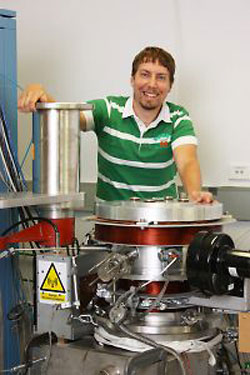| Jun 26, 2011 | |
Plasma physics finds novel applications in medicine |
|
| (Nanowerk News) Nosocomial Infections are those acquired whilst being treated in hospital for other conditions and are of very serious concern to the medical community. They are one of the major causes of death in hospitals, accounting for almost 100,000 annual fatalities in the USA alone. | |
| Although hospitals are kept scrupulously clean, the concentration of so many sick people tends to bring in a massive number of micro-organisms. The first line of defence against serious infection is of course antibiotics, but the problem is that the more these drugs are used, the more resistant strains begin to emerge and therefore the less effective they become. Whilst new antibiotics are being developed all the time, there's clearly a need for additional strategies to combat bacteria. One of the most recent to emerge has rather unlikely origins in a plasma physics laboratory. | |
 Dr Christian Sarra-Bournet Dr Christian Sarra-Bournet is a physicist working at the Australian National University in the Space Plasma, Power and Propulsion laboratory (SP3). "I was interested to explore alternative methods of treating bacterial infections especially nosocomial infections," he says, "and surprisingly enough there are some really strong links between materials with antibacterial properties and plasma processing." Titanium Dioxide TiO2 is most well known as the white pigment used in paints, but it has many other interesting properties. In its crystalline form, TiO2 is a semiconductor that exhibits some extraordinary photocatalytic properties. When ultra violet light shines on a TiO2 crystal, it generates electron-hole pairs, which can migrate to the surface to serve as a source of free electrons and electron absorbers. These form the basis for oxidation and reduction reactions, which can in turn create free radicals which attack the cell wall of bacteria, ultimately killing them. But the great thing about TiO2 is that it's relatively harmless to human tissue, it is even used in sunscreen as a UV absorber. "One of the limitations of TiO2 is that its large band gap requires ultra violet light to generate the electron hole pairs," Christian explains, "So what we wanted to do was devise a method of generating a doped version that would work in visible light and also be economical to produce." The method Christian chose was a process known as Helicon Assisted Reactive Sputtering, HAReS. This involves creating a plasma of oxygen and argon ions and using it to sputter material from a Titanium metal target. The sputtered titanium and oxygen vapour reacts in its plasma phase to create TiO2 whilst the argon provides a dense and effective plasma and because of its inert noble gas properties, it doesn't get in the way of the chemistry. By adding nitrogen to the plasma, Christian was able to create TiO2 doped with nitrogen atoms that was sensitive to visible light. |
|
| "In an environment like a hospital, there isn't that much ultraviolet light about, so by creating a material with the same antibacterial properties that's sensitive to visible light, we have something much more practical." | |
| But the antibacterial properties of TiO2 are not where its medical usefulness ends. TiO2 is an excellent biocompatible material and possesses bioactive properties: when TiO2 is exposed to fluids within the body, it will form a layer of Hydroxyapatite, a calcium mineral that accounts for about half the mass of human bones, without any additional intervention. | |
| For this reason, prosthetic bone implants such as replacement hips and knees are often given a TiO2 coating to enable them to bond strongly with living bone. The current method of producing this coating uses wet chemistry to deposit a thin layer then an annealing step at high temperature to give the TiO2 its crystal structure. Whilst this works fine on metal parts, the high temperature excludes its use for polymers, fabrics and other heat sensitive parts of medical implants. | |
| One of the advantages of Christian's technique is that the whole process is performed at room temperature, the crystallization being a natural result of the plasma/surface interactions while the semiconductor coating is being slowly deposited. Another advantage is that by varying the plasma conditions, it's possible to incorporate nitrogen or other elements and influence where they lie in the resulting crystal. "We've seen that the visible absorption, bioactivity and photocatalytic properties of the coatings are really dependent not only on the amount of dopant but also if the dopant replaces oxygen in the TiO2 structure or lies in one of the interstitial sites of the structure. Plasma processing allows us to fine tune the material properties." | |
| "This gives us a really powerful technique to produce coatings on medical implants that are not only effective in integrating with living bone tissue, but that also have natural antibacterial properties." | |
| "It's a really elegant system," Christian says, "With which we can tailor the TiO2 coating to suit a wide variety of needs ranging from bone implants to surgical tools and perhaps even nurse's uniforms." |
| Source: Australian National University |
